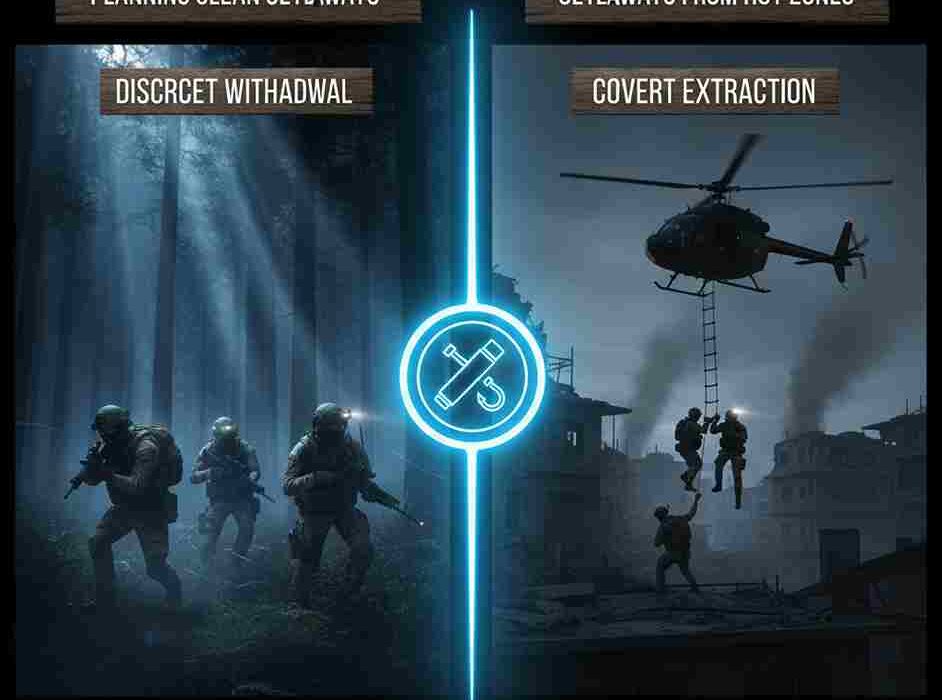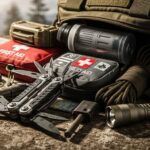In tactical operations, the extraction is often the most critical and vulnerable phase. Getting into the hot zone takes courage, but getting out cleanly takes meticulous planning, discipline, and the art of the Silent Exit. A clean getaway minimizes risk, conserves resources, and denies the adversary the opportunity for a counter-attack or pursuit. This isn’t about running; it’s about a disciplined transition from conflict to concealment.
Step 1: The Pre-Planned Exfil (Exfiltration) Route 🗺️
The decision to leave should be made long before the actual engagement. A successful silent exit relies entirely on preparation.
- Primary, Secondary, and Tertiary Routes: Never rely on a single way out. Plan multiple routes based on different scenarios (e.g., “North route is compromised,” “Vehicle extraction is impossible”). Each route must be surveyed for chokepoints, obstacles, and potential ambush sites.
- Contingency Points (Rally Points): Identify secure, pre-arranged locations outside the immediate hot zone where the team can regroup, assess casualties, and secure transportation. These must be easily identifiable and defensible.
- Time and Trigger: Determine the precise trigger for exfiltration. Is it a time limit? The completion of an objective? Or a hard stop based on enemy force severity? Knowing the “go” signal eliminates hesitation.

Step 2: The Tactical Disengagement (Break Contact) 💨
The immediate action when breaking contact is to create distance and disorientation.
- Violent, Controlled Withdrawal: The movement should be rapid but not chaotic. Use suppressive fire and smoke grenades to mask your movement and disorient the adversary. Smoke is your best friend—it breaks line of sight and degrades the enemy’s ability to maintain accurate fire.
- Echeloned Movement: Move in a phased, alternating pattern. One element provides covering fire and suppresses the enemy while the second element moves to the next point of cover. The first element then moves under the cover of the second, and so on. This maintains a continuous presence and prevents the enemy from realizing you are fully retreating until it’s too late.
- Avoid the Trail: Once out of sight, do not follow the most obvious or easiest path. Use dense cover, waterways, or difficult terrain to prevent immediate pursuit.
Step 3: Maintaining the Silent Signature 🤫
Once a safe distance is achieved, the focus shifts to maintaining complete stealth.
- Acoustic Discipline: All unnecessary noise must stop. This means radio chatter is reduced to the absolute minimum (brief, coded transmissions), gear is secured to prevent jingling, and movement is slow and deliberate.
- Light Discipline: All light sources are secured. No flashlights, no illuminated watch faces, and absolutely no electronics that can give off a light signature.
- Electronic Silence (EMCON): This is paramount. All communication devices are powered off or placed in Faraday bags to prevent the adversary from tracking your movement via cell pings or RF signals. You are now relying on pre-arranged rendezvous times or non-electronic signaling.
- No Traces: Do not leave behind unnecessary gear, trash, or obvious tracks. If time allows, obscure your path. Leaving evidence provides the enemy with actionable intelligence on your size, status, and direction of travel.
A silent exit transforms a moment of tactical vulnerability into a strategic advantage. It proves that the disciplined withdrawal is just as valuable as the aggressive entry.

















